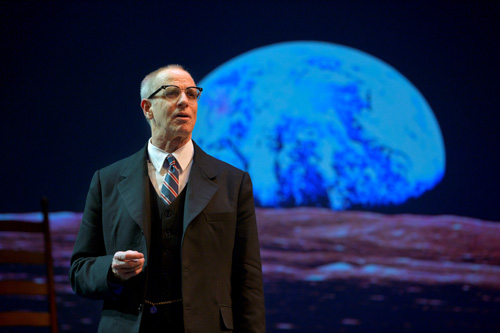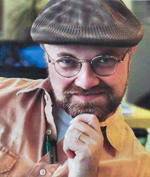
By Eric George Tauber

SAN DIEGO — Imagine a rounded arch made of triangles … structures of multiple triangles in tetrahedrons … globes of octohedrons. And on this globe, everyone works selflessly to provide for the betterment of humanity. War is replaced by coöperation. Want and excess give way to universal sufficiency. This is the world envisioned by inventor R. Buckminster Fuller. Giving us the grand tour of “Bucky’s” vision for “Spaceship Earth” is one-man tour de force Ron Campbell in R. Buckminster Fuller: The History (and Mystery) of the Universe at the Lyceum Theatre.
Like a wacky professor, his speech is excited and erratic, punctuated by pregnant silences that hold us in rapt attention.
As a small, cross-eyed child, “Bucky” was given some sticks and joints in which to make different shapes. Finding squares flimsy, he preferred the solidity of triangles. Combining triangles, he put together an octahedron, getting the attention of his teachers.
As a young man, he went to Harvard. But after ditching too many classes, he was dismissed … twice.
Years later, after a devastating business failure, Bucky decided to not be a failure, but to discover what a single human being could achieve. To do this, he had to re-think the universe. To do that, he had to “unlearn” what he thought he knew. To truly understand how things worked, he looked not to other inventions, but to nature.
“Gravity never stops to think.
Nature doesn’t need a committee meeting to decide what to do. Scientists do.”
His “dymaxian house” was a model of functionality and conservation complete with waterless toilets. His geodesic domes, circles composed of triangles, are popular with children’s playgrounds. To host World’s Fairs, the cities of Montreal and Seattle sport them on a much grander scale.
“I was judged a failure because I never made money
from my designs. But that was never my goal.”
He makes no effort to mask his disdain for the Wall Street moguls who value profit over virtue and exploitation over humanity. He drives home the idea that all the resources we need are at hand. What is lacking is vision and will.
“We can take care of everyone. And if we did,
the whole raison d’etre for war would disappear.
… But can we convince humanity to save itself…?”
The many projections designed by Jim Findlay are as much a part of the show as the actor. The screen is like a stage for Bucky’s ideas to dance upon.
Kudos to Campbell’s mime training. Whenever he’s pulling an invisible rope or walking against the wind, his movements are fluid and strong. But I would expect no less of a former lead clown with Cirque du Soleil.
“There is no energy shortage.
There is no energy crisis.
There is only a crisis of ignorance.”
Our Sage, Hillel posed the question, “If I am only for myself, what am I?” R. Buckminster Fuller was not a man for himself but for the world. And the world has a long way to go to catch up to his vision for humanity. So if you want to take a step in that direction, come to the Lyceum Theatre.
Oh, and be prepared to answer questions, stand up and sing along. Class is in session.
*
Tauber is a freelance writer specializing in coverage of the arts. He may be contacted via eric.tauber@sdjewishworld.com Comments intended for publication below should be accompanied by the letter writers first and last name and his her city and state of residence.